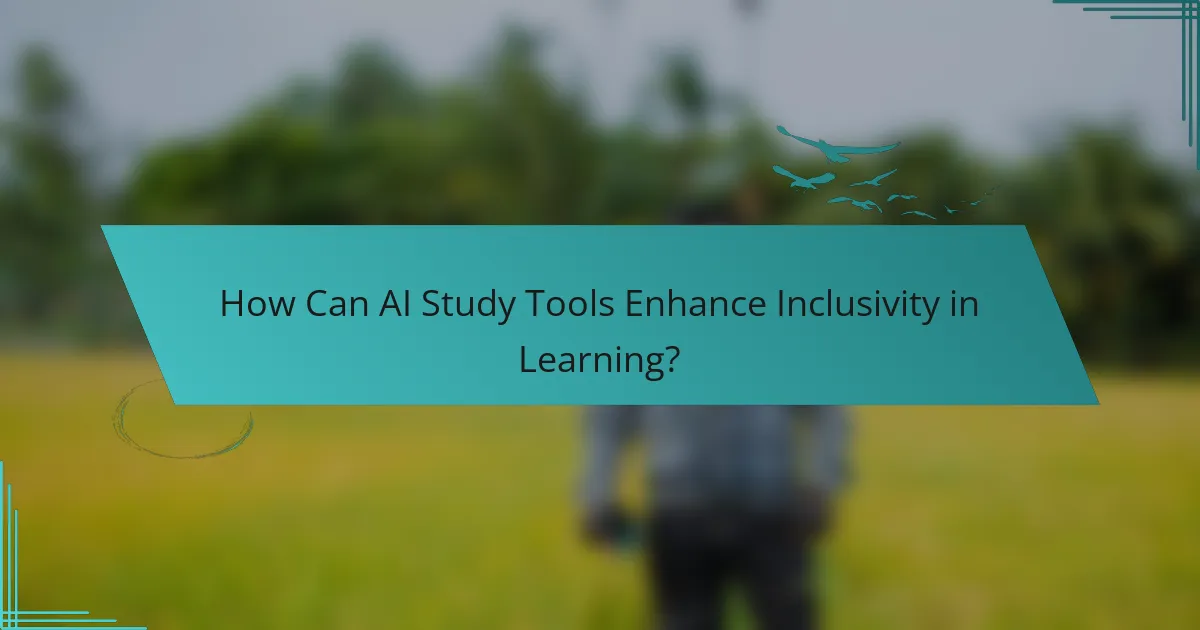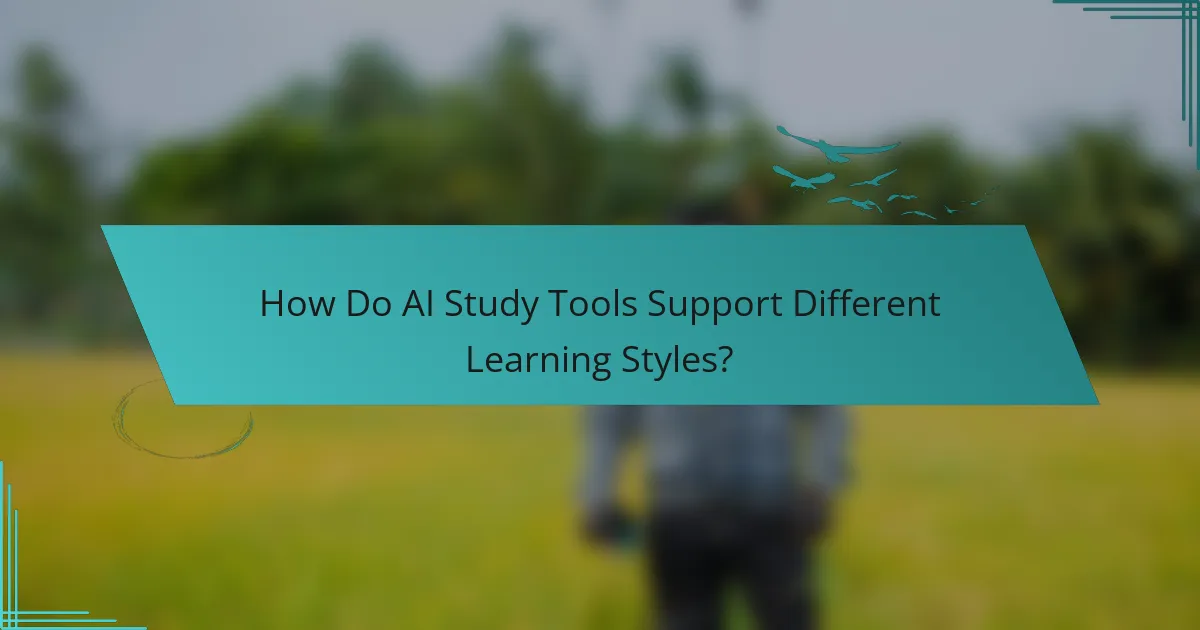AI study tools play a crucial role in fostering inclusive learning environments by offering personalized educational experiences that address the unique needs of each learner. By utilizing data and algorithms, these tools ensure that students from diverse backgrounds and abilities can effectively engage with and access educational content, ultimately enhancing understanding and retention across various learning styles.

How Can AI Study Tools Enhance Inclusivity in Learning?
AI study tools can significantly enhance inclusivity in learning by providing tailored educational experiences that cater to individual needs. These tools leverage data and algorithms to create personalized pathways, ensuring that all learners, regardless of their backgrounds or abilities, can access and engage with educational content effectively.
Personalized learning experiences
Personalized learning experiences allow students to progress at their own pace, adapting to their unique learning styles and preferences. AI study tools can analyze a learner’s performance and adjust the difficulty of tasks, recommend resources, or suggest study schedules tailored to their strengths and weaknesses.
For instance, a student struggling with math concepts might receive additional practice problems focused on those areas, while another excelling in reading comprehension could be directed towards more challenging texts. This targeted approach helps maintain engagement and fosters a deeper understanding of the material.
Accessibility features for diverse learners
Accessibility features in AI study tools are essential for supporting diverse learners, including those with disabilities. Tools can incorporate text-to-speech, speech-to-text, and customizable font sizes or colors to accommodate various needs, ensuring that all students can interact with the content.
For example, a visually impaired student might benefit from audio descriptions of visual materials, while a student with dyslexia could use tools that highlight text as it is read aloud. These features not only enhance usability but also promote a more inclusive learning environment.
Real-time feedback mechanisms
Real-time feedback mechanisms provided by AI study tools enable students to receive immediate insights into their performance, which is crucial for effective learning. Instant feedback helps learners identify areas for improvement and adjust their study strategies accordingly.
For example, an AI tool might highlight incorrect answers and offer hints or explanations, allowing students to understand their mistakes and learn from them on the spot. This immediacy can significantly enhance motivation and retention, as students feel supported throughout their learning journey.

What Are the Best AI Study Tools for Inclusive Education?
The best AI study tools for inclusive education enhance learning by accommodating diverse needs and learning styles. These tools provide personalized experiences, making education more accessible for all students.
Microsoft Learning Tools
Microsoft Learning Tools offer features designed to support students with different learning abilities. Tools such as Immersive Reader help improve reading comprehension by providing text-to-speech, adjustable text size, and translation options.
Additionally, the platform includes features like dictation and speech recognition, which assist students with writing challenges. These tools can be easily integrated into Microsoft Word and OneNote, making them readily available for classroom use.
Google Classroom with AI integrations
Google Classroom, enhanced with AI integrations, streamlines the educational experience for teachers and students alike. Features like automatic grading and personalized feedback help educators manage diverse learning paces effectively.
AI-driven tools within Google Classroom can analyze student performance and suggest tailored resources, ensuring that each student receives the support they need. This adaptability makes it easier for teachers to create inclusive lesson plans that cater to all learners.
Quizlet and its adaptive learning features
Quizlet employs adaptive learning features to customize study sessions based on individual student performance. This means that as students engage with the material, the platform adjusts the difficulty and type of questions to better suit their learning needs.
With options like flashcards, practice tests, and interactive games, Quizlet makes studying more engaging. Educators can create custom study sets that align with their curriculum, ensuring that all students can access relevant and inclusive learning materials.

How Do AI Study Tools Support Different Learning Styles?
AI study tools cater to various learning styles by providing tailored resources that enhance understanding and retention. These tools leverage technology to adapt content delivery, making learning more accessible and effective for visual, auditory, and kinesthetic learners.
Visual learning enhancements
Visual learners benefit from AI study tools that incorporate graphics, charts, and videos to convey information. These resources can simplify complex concepts and improve memory retention through visual associations. For instance, platforms may use infographics to summarize key points or interactive simulations to illustrate processes.
Additionally, AI can analyze a learner’s preferences and suggest visual content that aligns with their study habits. Tools like mind mapping software or video tutorials can further enhance visual engagement, making it easier for learners to grasp and recall information.
Auditory support through AI
Auditory learners thrive with AI tools that offer spoken content, such as podcasts, audiobooks, and voice-activated study aids. These resources allow learners to absorb information through listening, which can be particularly effective for those who struggle with traditional reading. AI-driven applications can also provide personalized audio summaries or quizzes to reinforce learning.
Moreover, incorporating speech recognition technology enables learners to engage in interactive discussions, enhancing their understanding through verbal practice. This approach can be especially useful for language acquisition or subjects requiring verbal articulation.
Kinesthetic learning applications
Kinesthetic learners excel when they can engage physically with study materials. AI study tools can facilitate this through interactive simulations, gamified learning experiences, and hands-on activities. For example, virtual labs allow learners to conduct experiments in a controlled environment, providing practical experience without the need for physical materials.
Additionally, AI can track a learner’s progress and suggest activities that promote active participation, such as role-playing scenarios or movement-based tasks. This approach not only keeps learners engaged but also reinforces concepts through physical involvement, catering to their unique learning style.

What Criteria Should Educators Use to Select AI Study Tools?
Educators should consider several key criteria when selecting AI study tools, including alignment with curriculum standards, user-friendliness, and cost-effectiveness. These factors ensure that the tools not only enhance learning but also fit within the educational framework and budget constraints.
Alignment with curriculum standards
AI study tools must align with established curriculum standards to effectively support educational goals. This means they should cover the required content and skills outlined by local education authorities or national frameworks.
For example, tools that assist with STEM subjects should incorporate relevant mathematical concepts and scientific principles as defined by the Next Generation Science Standards (NGSS) or similar guidelines. Educators should review how well a tool meets these standards before implementation.
User-friendliness for students and teachers
User-friendliness is crucial for both students and teachers to maximize the effectiveness of AI study tools. A tool should have an intuitive interface that allows users to navigate easily without extensive training.
Consider tools that offer features like interactive tutorials, clear instructions, and responsive customer support. Gathering feedback from students and teachers during the selection process can help identify which tools are most accessible and engaging.
Cost-effectiveness and licensing options
Cost-effectiveness is a significant factor when selecting AI study tools, especially for schools with limited budgets. Educators should evaluate the total cost of ownership, including initial purchase price, subscription fees, and any additional costs for updates or support.
Licensing options can vary widely; some tools offer free versions with limited features, while others may require annual subscriptions. Comparing these options can help educators find a balance between quality and affordability, ensuring they choose tools that provide the best value for their investment.

How Can Educators Implement AI Study Tools Effectively?
Educators can implement AI study tools effectively by focusing on training, integration, and evaluation. These steps ensure that the tools enhance learning experiences while being accessible and beneficial for all students.
Training and professional development
Effective implementation of AI study tools begins with comprehensive training for educators. Professional development programs should focus on how to use these tools to support diverse learning needs and foster inclusive environments.
Workshops and online courses can help educators understand the functionalities of AI tools, including how to customize them for different student requirements. Ongoing support and resources are essential to keep educators updated on advancements in AI technology.
Integration with existing systems
Integrating AI study tools with existing educational systems is crucial for seamless adoption. Educators should assess current platforms and identify how AI tools can complement or enhance these systems.
Consideration should be given to compatibility with Learning Management Systems (LMS) and other digital resources. A phased approach to integration can help minimize disruptions, allowing educators and students to adapt gradually.
Monitoring and evaluating tool effectiveness
Monitoring and evaluating the effectiveness of AI study tools is vital to ensure they meet educational goals. Educators should establish clear metrics for success, such as student engagement levels and academic performance improvements.
Regular feedback from students can provide insights into how well the tools are working and where adjustments may be needed. Utilizing data analytics can help in assessing the impact of these tools on learning outcomes, guiding future decisions on their use.
